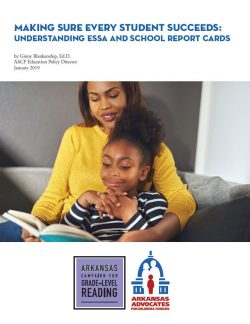
Arkansas Advocates for Children and Families and the Arkansas Campaign for Grade-Level Reading have produced a new guide to help parents understand the federal Every Student Succeeds Act (ESSA). The Arkansas Department of Education now uses ESSA to measure how Arkansas’s students and schools perform.
Arkansas’s ESSA plan is a welcome shift from the one-size-fits-all accountability model of No Child Left Behind. But the methodology behind school report cards is still a mystery to most parents. We hope this guide will help parents understand the big picture and know how to find more information.
Under Arkansas’s ESSA plan, the state’s long-term goal is for 80 percent of all students to be proficient in reading and math by 2029. The new guide outlines several important pieces of information:
- The testing required by Arkansas’s ESSA plan
- The formula used to calculate school performance ratings
- The importance of growth scores
- What’s behind school letter grades
- How the Department plans to support school districts
- Where to find this information online
AACF recommends that the state amend its ESSA plan to give even greater weight to growth in school ratings, which gives a better picture of how schools are helping improve student achievement. Measuring growth is especially important for schools with many low-income students, who tend to score below the state average on standardized tests. However, the report notes, “Students in poverty are certainly as capable as their more advantaged peers, and schools must do all they can to make sure these kids have everything they need to learn and thrive.”
To download a copy of the guide, click the button below.
